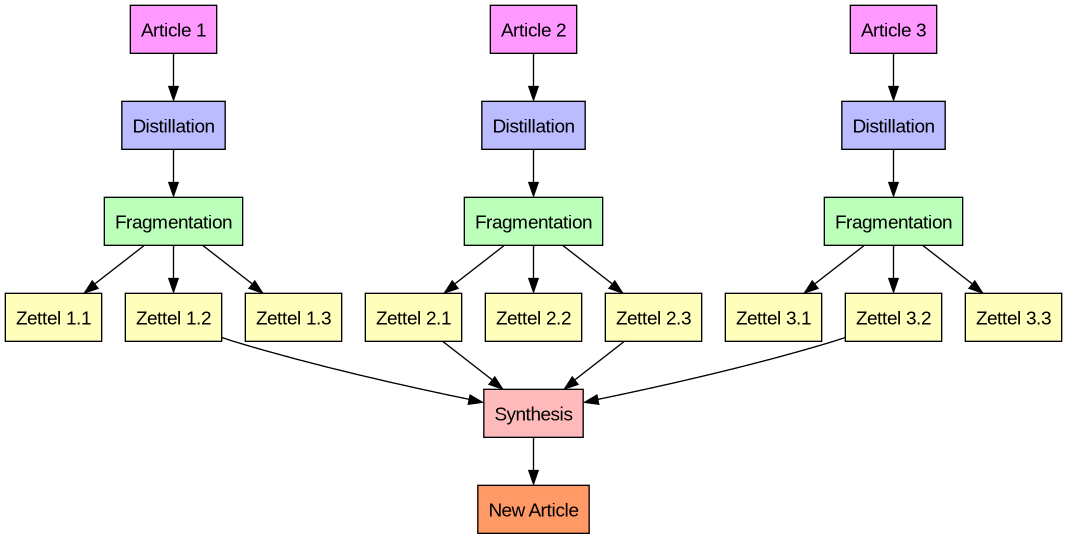# NKBIP-01
[Source](https://github.com/limina1/NKBIPs)
This NKBIP defines the minimum specification required for a Nostr knowledge base (NKB). It also describes possibilities for customizing the events or expanding off from the basic structure. An implementation of event creation can be found in the GC-Alexandria (Wikistr, Wikifreedia) client.
## Why modular articles?
### Semantic closure
Composable objects that are able to generate self contained meaning given the knowledge they draw from, are referred to as Semantic closure (Wikistr, Wikifreedia). When citing an idea, the standard practice is to cite the full text, but this practice fails for longer texts.
Search and navigation: An article may have multiple concepts contained, but they may not be apparent through just the title or summary/abstract. Multiple articles may also contain an explanation of a single concept and individuals may need to read multiple takes on a single concept to understand it.
### Remixability
Instead of writing a unique introduction, take an existing article fragment and use it as a section in your own article.
### Organic structure
A project can encompass many ideas to describe and build. If you want to teach machine learning you may want to pull in concepts from linear algebra, probability, numerical libraries for matrix algebra to fully explain what you are doing and detail the various aspects of your project. An anatomy textbook can link concepts together not only linearly but by anatomical relation. Not only can articles be read linearly but they themselves can be their own sub-network of hyperlinks to related concepts at various levels of organization.
## Implementation
The most basic article can be constructed through two kinds with an analog to the standard kind 0 and kind 1 defined in NIP-01 (Wikistr, Wikifreedia) and influence taken from NIP-23 (Wikistr, Wikifreedia) and NIP-54 (Wikistr, Wikifreedia):
### 30040: Index
The following rules are mandatory:
-
There is no
content -
The full title of the index or collection MUST be indicated by the
title -
The index MUST also be uniquely identifiable using a combination of the
dtitlepubkeykind -
Kind 30040 is REQUIRED to have events listed in
e -
If the index is a derivation or an edit of another event, the pubkey that published the original MUST be indicated by a
pep
The following rules are optional:
-
One or more authors MAY be listed in the
authorauthorpubkey -
The ISBN number of the work MAY be listed in the
ISBN -
The
t -
The
published_onpublished_bypublished_on -
The
image -
The
summary -
The
version
{
"id": "<event_id>",
"pubkey": "<event_originator_pubkey>",
"created_at": <timestamp>,
"kind": 30040,
"tags": [
[ "d", "<identifier>" ],
[ "title", "<full_index_title>" ],
[ "author", "<author_name>" ],
[ "ISBN", "<ISBN>" ],
[ "t", "<topics about which the event might be of relevance>"],
[ "published_on", "<date in the format YYYY-MM-DD>" ],
[ "published_by", "<publisher of the source material>"],
[ "image", "<URL pointing to an image to be shown with the title>" ],
[ "summary", "<human readable description of the work>" ],
[ "version", "<the volume, edition, or translation included>" ],
[ "e", "<event_0_id>", "<relay_0_uri>", ..., "<relay_n_uri>" ],
[ "e", "<event_1_id>", "<relay_0_uri>", ..., "<relay_n_uri>" ],
...
[ "e", "<event_n_id>", "<relay_0_uri>", ..., "<relay_n_uri>" ],
[ "p", "<pubkey_0>", "<pubkey_1>", ..., "<pubkey_n>" ],
[ "e", "<original_event_id>", "<relay_0_uri>", ..., "<relay_n_uri>" ]
],
"sig": "<event_signature>"
}### Section/Article Note
The following rules are mandatory:
-
The article MUST contain a
d -
The article MUST contain a
title -
The
content -
The
content
Additional optional tags, akin to those for 30040 kind MAY be used.
{
"id": "5a09d5c2a281c821ae61...",
"pubkey": "8ae74c618a4713f32129...",
"created_at": 1708083476,
"kind": 30041,
"tags": [
[ "title", "Events and signatures" ],
[ "d", "events-and-signatures" ]
],
"content": "## Events and Signatures\nEach user has a keypair. Signatures, public key, and encodings are done according to the Schnorr signatures standard for the curve secp256k1.\nThe only object type that exists is the event , which has the following format on the wire:\n...",
"sig": "49cab8c75fb35cec71d07258..."
}### Labels
This NIP defines the core events for publishing some document. Additional value is added through the curation of documents published, including other npub’s documents.
One method for doing this is through labeling (as in NIP-32 (Wikistr, Wikifreedia)). Labels could be used to add metadata to indexes or sections, and also to "externally tag" a particular event for some other use.
A label for embeddings is described in NKBIP-02 (Wikistr, Wikifreedia).
